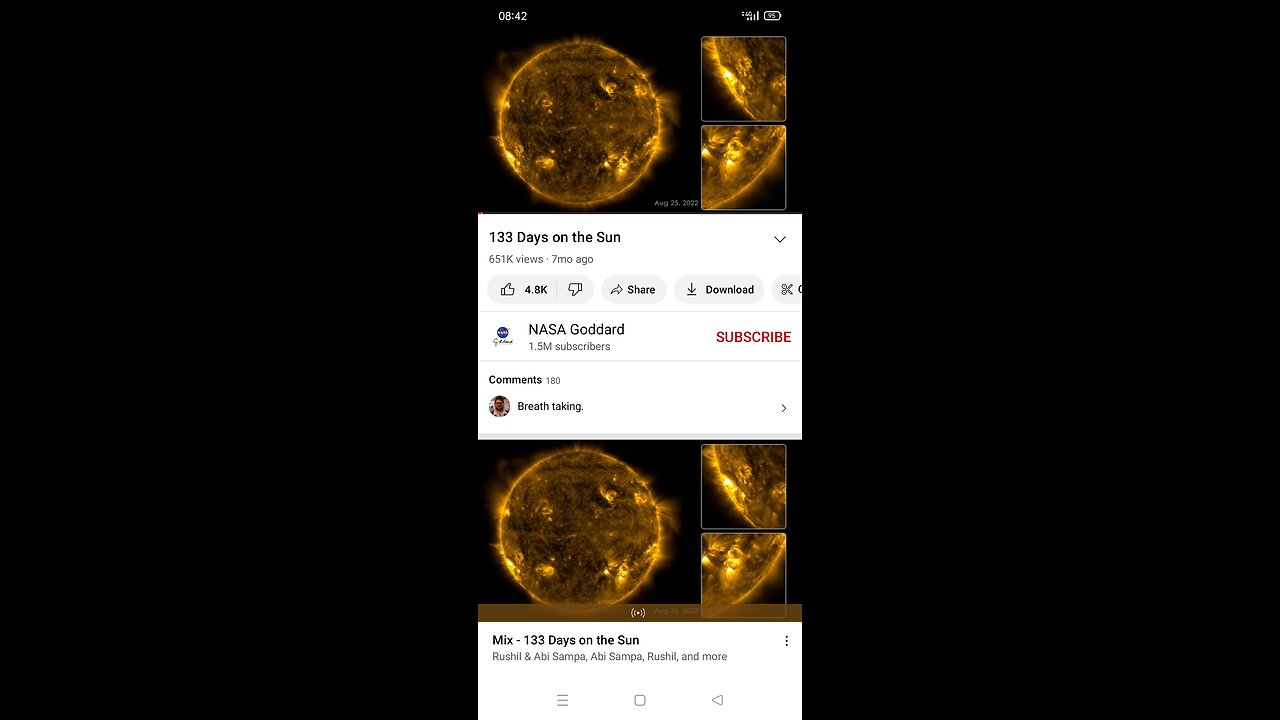Premium Only Content

Nasa | 133 days On sun
This video chronicles solar activity from Aug. 12 to
Dec. 22, 2022, as captured by NASA's Solar Dynamics
Observatory (SDO). From its orbit in space around
Earth, SD0 has steadily imaged the Sun in 4K x 4K
resolution for nearly 13 years. This information has
enabled countless new discoveries about the
workings of our closest star and how it influences the
solar system.
With a triad of instruments, SD0 captures an image of
the Sun every 0.75 seconds. The Atmospheric
Imaging Assembly (AIA) instrument alone captures
images every 12 seconds at 10 different wavelengths
of light. This 133-day time lapse showcases photos
taken at a wavelength of 17.1 nanometers, which is an
extreme-ultraviolet wavelength that shows the Sun's
outermost atmospheric layer: the corona. Compiling
images taken 108 seconds apart, the movie
condenses 133 days, or about four months, of solar
observations into 59 minutes. The video showS bright
active regions passing across the face of the Sun as it
rotates. The Sun rotates approximately once every 27
days. The loops extending above the bright regions
are magnetic fields that have trapped hot, glowing plasma. These bright regions are also the source of
solar flares, which appear as bright flashes as
magnetic fields snap together in a process called
magnetic reconnection.
While SDO has kept an unblinking eye pointed toward
the Sun, there have beena few moments it missed.
Some of the dark frames in the video are caused by
Earth or the Moon eclipsing SDO as they pass
between the spacecraft and the Sun. Other blackouts
are caused by instrumentation being down or data
errors. SDO transmits 1.4 terabytes of data to the
ground every day. The images where the Sun is
off-center were observed when SDO was calibrating
its instruments.
SDO and other NASA missions will continue to watch
our Sun in the years to come, providing further
insights about our place in space and information to
keep our astronauts and assets safe.
The music is a continuous mix from Lars Leonhard's
"Geometric Shapes" album, courtesy of the artist.
Credit: NASA's Goddard Snace Fliaht Center
Video Description:
On the left side of the frame is the full circle of the
Sun. It appears in a golden yellow color, but splotchy
and with thin yellow wisps extending from the surface.
Some areas are very bright and others almost black.
The whole Sun rotates steadily, with one full rotation
taking 12 minutes in this time lapse. There are usually
only a few bright regions visible at a time and they
shift and flash like small fires. From these regions
there are wispy loops reaching up above the surface
that rapidly change shape and size.
On the right side of the frame are two white-outlined
squares with enlargements of interesting regions of
the Sun.
If you liked this video, subscribe to the NASA Goddard
Video Description:
On the left side of the frame is the full circle of the
Sun. It appears in a golden yellow color, but splotchy
and with thin yellow wisps extending from the surface.
Some areas are very bright and others almost black.
The whole Sun rotates steadily, with one full rotation
taking 12 minutes in this time lapse. There are usually
only a few bright regions visible at a time and they
shift and flash like small fires. From these regions
there are wispy loops reaching up above the surface
that rapidly change shape and size.
On the right side of the frame are two white-outlined
squares with enlargements of interesting regions of
the Sun.
If you liked this video, subscribe to the NASA Goddard
Video Description:
On the left side of the frame is the full circle of the
Sun. It appears in a golden yellow color, but splotchy
and with thin yellow wisps extending from the surface.
Some areas are very bright and others almost black.
The whole Sun rotates steadily, with one full rotation
taking 12 minutes in this time lapse. There are usually
only a few bright regions visible at a time and they
shift and flash like small fires. From these regions
there are wispy loops reaching up above the surface
that rapidly change shape and size.
On the right side of the frame are two white-outlined
squares with enlargements of interesting regions of
the Sun.
If you liked this video, subscribe to the NASA Goddard
YouTube channel: / nasagoddard
-
 DVR
DVR
Dr. Eric Berg
4 days agoThe Dr. Berg Show LIVE April 25, 2025
2.79K2 -
 LIVE
LIVE
The Mel K Show
1 hour agoMORNINGS WITH MEL K - 4/25/25 Watch the Water, Redoubling Election Integrity Effort Before 2026, Where are the Representatives of the People?
514 watching -
 LIVE
LIVE
BitLab Academy
1 hour agoBlackrock & China Pump Bitcoin & Altcoin Pump Season & Maximize Crypto Profits With Defi
290 watching -
 11:08
11:08
SLS - Street League Skateboarding
1 day agoNyjah Huston on his most memorable SLS Wins, Nollie Flip Back Lips, the SLS Miami Course & more...
2.27K2 -
 LIVE
LIVE
Film Threat
13 hours agoTHE ACCOUNTANT 2 + CHEECH & CHONG + TONS OF REVIEWS! | Film Threat Livecast
53 watching -
 LIVE
LIVE
Tudor Dixon
2 hours agoThe Impact of the Biden Pill Penalty with Tim Murtaugh | The Tudor Dixon Podcast
30 watching -
 14:35
14:35
SKAP ATTACK
27 minutes agoThe Denver Nuggets are a Disgrace
-
 59:26
59:26
VINCE
3 hours agoJUSTICE! FBI Arrests Corrupt Judge - w/ Guest Mike Davis | Episode 30 - 04/25/25
160K113 -
 2:33:25
2:33:25
Matt Kohrs
10 hours agoMarkets Finally Push Higher!!! || The MK Show
67.4K -
 DVR
DVR
Bannons War Room
2 months agoWarRoom Live
14M3.53K